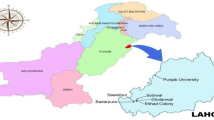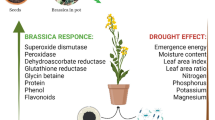Abstract
Acid rain has become a major concern due to increasing atmospheric pollution, particularly in China. We investigated whether acid rain inhibits the germination of seeds and subsequent emergence of seedling of four tree species from southern China: Cunninghamia lanceolata, Fokienia hodginisi, Pinus massoniana and Phoebe zhennan by simulating acid rain with pH of 2.5, 3.5, 4.5 and 5.5. We hypothesized that the inhibitory effect of acid rain on germination of seeds and emergence of seedling varies between species and the degree of acidity. A solution of 1 N H2SO4 and 1 N HNO3 in the ratio of 10–1 was prepared and diluted to four pH levels, and seeds were supplied with solutions of these pH values and distilled water as control and tested for germination in a controlled growth chamber. The results revealed that simulated acid rain of pH 2.5 adversely affected the germination capacity of F. hodginisi and P. zhennan; while all acid solutions significantly increased germination of P. Massoniana; but had no effect on germination of C. Lanceolata seeds. Strong acid solution (pH of 2.5) adversely affected elongation of radicle and hypocotyl as well as fresh and dry weights of radicle and hypocotyl of tender seedlings. The result demonstrated that seedling emergence is more sensitive than seed germination to simulated acid rain, and germination of conifer species are less sensitive than broad leaved species to simulated acid rain. As a whole, acid rain of pH of 3.5 is the threshold level and acid rain below this value will have a detrimental effect on seed germination and seedling emergence.




Similar content being viewed by others
References
Allen HL (1994) Nutritional response of loblolly pine exposed to ozone and simulated acid rain. Can J For Res 24:253–462
Anitha PC, Ramanujan MP (1992) Impact of simulated acid rain on germination and seedling growth of ground nut. Adv Plant Sci 5:180–186
Ashenden TW, Bell SA (1989) Growth responses of three legume species exposed to simulated acid rain. Environ Pollut 62:21–29
Bewley JD, Bradford KJ, Hilhorst HWM, Nonogaki H (2013) Seeds: physiology of development, germination and dormancy, 3rd edn. Springer, New York
Bian YM, Yu SW (1992) Forest decline in Nanshan, China. For Ecol Manag 51(1–3):53
Britton KO, Berrang P, Mavity E (1996) Effects of pretreatment with simulated acid rain on the severity of dogwood anthracnose. Plant Dis 80(6):646–649
Byres DP, Dean TJ, Johnson JD (1992) Long-term effects of ozone and simulated acid rain on the foliage dynamics of slash pine (Pinus elliottii var. elliottii Engelm.). New Phytol 120(1):61–67
Cao YZ, Wang S, Zhang G, Luo J, Lu S (2009) Chemical characteristics of wet precipitation at an urban site of Guangzhou, South China. Atmos Res 94(3):462–469
Chao WL (1995) Effect of acid rain on the nitrifying activity of copper amended soil left in applied microbial. Lett Appl Microbiol 21:23–24
Chen L, Heerink N, van den Berg M (2006) Energy consumption in rural China: a household model for three villages in Jiangxi Province. Ecol Econ 58(2):407–420
Chen Q, Chen H, Wang W, Liu J, Zhang J (2017) Glycyrrhetic acid, but not glycyrrhizic acid, strengthened entecavir activity by promoting its subcellular distribution in the liver via efflux inhibition. Eur J Pharm Sci 106:313–327
Cheng Y, Liu Y, Huo M, Sun Q, Wang H, Chen Z, Bai Y (2011) Chemical characteristics of precipitation at Nanping Mangdang Mountain in eastern China during spring. J Environ Sci 23(8):1350–1358
Cox RM (1983) Sensitivity of forest plant reproduction to long range transported air pollutants: in vitro sensitivity of pollen to simulated acid rain. New Phytol 95:269–276
Cui J, Zhou J, Peng Y, He Y, Yang H, Mao J (2014) Atmospheric wet deposition of nitrogen and sulfur to a typical red soil agroecosystem in Southeast China during the ten-year monsoon seasons (2003–2012). Atmos Environ 82:121–129
Dolatabadian A, Sanavy SAMM, Gholamhoseini M, Joghan AK, Majdi M, Kashkooli AB (2013) The role of calcium in improving photosynthesis and related physiological and biochemical attributes of spring wheat subjected to simulated acid rain. Physiol Mol Biol Plants 19(2):189–198
Dong L, Dong H, Fujita T, Geng Y, Fujii M (2015) Cost-effectiveness analysis of China’s Sulfur dioxide control strategy at the regional level: regional disparity, inequity, and future challenges. J Clean Prod 90:345–359
Eldhuset TD, Teigen O, Bjor K (1994) Germination and seedling development. In: Abrahamsen G, Stuanes AO, Tveite B (eds) Long-term experiments with acid rain in norweigian forest ecosystems. Springer, New York, pp 287–294
Evans LS (1982) Biological effects of acidity in precipitation on vegetation: a review. Environ Exp Bot 22:155–160
Fan BT (1993) Environmental chemistry. Zhejiang University Press, Hongzhou (in Chinese)
Fan HB, Wang YH (2000) Effects of simulated acid rain on germination, foliar damage, chlorophyll contents and seedling growth of five hardwood species growing in China. For Ecol Manag 126(3):321–329
Flegal AR, Gallon C, Ganguli PM, Conaway CH (2013) All the lead in China. Crit Rev Environ Sci Technol 43(17):1869–1944
Foyer CH, Noctor G (2005) Oxidant and antioxidant signaling in plants: a reevaluation of the concept of oxidative stress in a physiological context. Plant Cell Environ 28:1056–1071
Halman JM, Schaberg PG, Hawley GJ, Eagar C (2008) Calcium addition at the Hubbard Brook Experimental Forest increases sugar storage, antioxidant activity and cold tolerance in native red spruce (Picea rubens). Tree Physiol 28(6):855–862
Hartmann HT, Kester DE, Davies FT, Geneve RL (2002) Plant propagation: principles and practices, 7th edn. Prentice-Hall, Upper Saddle River
Huang K, Zhuang G, Xu C, Wang Y, Tang A (2008) The chemistry of the severe acidic precipitation in Shanghai, China. Atmos Res 89(1–2):149–160
Huang L, Yang J, Zhang G (2012) Chemistry and source identification of wet precipitation in a rural watershed of subtropical China. Chin J Geochem 31(4):347–354
Jacobsen JS, Bethard T, Heller LI, Lassoie JP (1990) Response of Picea rubens seedlings to intermittent mist varying in acidity, and in concentrations of sulfur-, and nitrogen-containing pollutants. Physiol Plant 78:595–601
Kim GT (1987) Effects of simulated acid rain on growth and physiological characteristics of Ginkgo biloba L. seedlings and on chemical properties of the tested soil I. Seed germination and growth. J Korean For Soc 76:99–108
Kochian LV, Hoekenga OA, Piñeros MA (2004) How do crop plants tolerate acid soils? Mechanisms of aluminum tolerance and phosphorous efficiency. Annu Rev Plant Biol 55:459–493
Lan X, Yan Y, Yang B, Li X, Xu F (2019) Subcellular distribution of cadmium in a novel potential aquatic hyperaccumulator—Microsorum pteropus. Environ Pollut 248:1020–1027
Larssen T, Schnoor JL, Seip HM, Dawei Z (2000) Evaluation of different approaches for modeling effects of acid rain on soils in China. Sci Total Environ 246(2–3):175–193
Lee JJ, Weber DE (1979) The effects of simulated acid rain on seedling emergence and growth of eleven woody species. For Sci 25:393–398
Liao LP, Chen CY (1992) Relationships between simulated acid rain, soil acidification and root growth of Chinese fir and Schima superba, Chinese. J Ecol 11:23–28 (in Chinese with an English abstract)
Macaulay BM, Enahoro GE (2015) Effects of simulated acid rain on the morphology, phenology and dry biomass of a local variety of maize (Suwan-1) in Southwestern Nigeria. Environ Monit Assess 187(10):622. https://doi.org/10.1007/s10661-015-4844-4
McColl JG, Johnson R (1983) Effects of simulated acid rain on germination and early growth of Douglas-fir and ponderosa pine. Plant Soil 74:125–129
Mei XY, Yang Y, Fang JD (2010) Regime shift of acid rain type in area of Shanghai. Resour Environ Yangtze Basin 19:1075–1079 (in Chinese)
Moore AM, Gillette A (1988) Germination of red spruce and Fraser fir seeds exposed to simulated acid rain. J Elisha Mitchell Sci Soc 104:137–140
Niu YW, Gu JQ, Yu XM, Jiang HR, Dai X (2010) The chemical feature of precipitation in the Yangtze River Delta background region. Environ Chem 29:358–362
Paolacci S, Harrison S, Jansen MA (2018) Are alien species necessarily stress sensitive? A case study on Lemna minuta and Lemna minor. Flora 249:31–39
Park BB, Yanai RD (2009) Nutrient concentrations in roots, leaves and wood of seedling and mature sugar maple and American beech at two contrasting sites. For Ecol Manag 258:1153–1160
Percy K (1986) The effects of simulated acid rain on germinative capacity, growth and morphology of forest tree seedlings. New Phytol 104:473–484
Rajjou L, Duval M, Gallardo K, Catusse J, Bally J, Job C, Job D (2012) Seed germination and vigor. Annu Rev Plant Biol 63:507–533
Raynal DJ, Roman JR, Eichenlaub WM (1982) Response of tree seedlings to acid precipitation: effect of substrate acidity on seed germination. Environ Exp Bot 22(3):377–383
Scherbatskoy T, Klein RM, Badger GJ (1987) Germination responses of forest tree seed to acidity and metal ions. Environ Exp Bot 27:157–164
Shan YF, Feng ZW (1989) Effects of simulated acid rain on seedlings of Cyclobalano glauca Oerst. In: Yang HX (ed) Acid rain and agriculture. China Forestry Press, Beijing, pp 174–178 (in Chinese)
Shi CE, Xueliang D, Yuanjian Y, Xiangrong H, Biwen W (2014) Precipitation chemistry and corresponding transport patterns of influencing air masses at Huangshan Mountain in East China. Adv Atmos Sci 05:1157–1166
Tigabu M, Odén PC (2001) Effects of scarification, gibberellic acid and temperature on seed germination of two multipurpose Albizia species from Ethiopia. Seed Sci Technol 29(1):11–20
Wang H, Han G (2011) Chemical composition of rainwater and anthropogenic influences in Chengdu, Southwest China. Atmos Res 99(2):190–196
Wang WX, Xu PJ (2009) Research progress in precipitation chemistry in China. Prog Chem 21:266–281 (in Chinese)
Xie Z, Du Y, Zeng Y, Li Y, Wu J, Jiao S (2008) Impact of spatio-temporal variation of precipitation on severe acid rain in southern China. Acta Geogr Sin 63:913–923
Zar J (1996) Biostatistical analysis, 3rd edn. Prentice-Hall, Upper Saddle River
Zhang X, Chai F, Wang S, Sun X, Han M (2010) Research progress of acid precipitation in China. Res Environ Sci 23(5):527–532
Zida D, Tigabu M, Sawadogo L, Odén PC (2005) Germination requirements of seeds of four woody species from the Sudanian savanna in Burkina Faso, West Africa. Seed Sci Technol 33(3):581–593
Author information
Authors and Affiliations
Corresponding author
Additional information
Publisher's Note
Springer Nature remains neutral with regard to jurisdictional claims in published maps and institutional affiliations.
Project funding: This study is financially supported by the Innovation and Industrialization Project of Advanced Generations of Chinese Fir in Fujian Forestry Department (ZYCX-LY-2017004) and the Science and Technology Major Project of Fujian Province, China (2018NZ0001-1).
The online version is available at http://www.springerlink.com
Corresponding editor: Yu Lei.
Rights and permissions
About this article
Cite this article
Gilani, M.M., Tigabu, M., Liu, B. et al. Seed germination and seedling emergence of four tree species of southern China in response to acid rain. J. For. Res. 32, 471–481 (2021). https://doi.org/10.1007/s11676-020-01102-0
Received:
Accepted:
Published:
Issue Date:
DOI: https://doi.org/10.1007/s11676-020-01102-0




